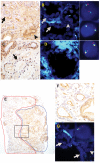PTEN loss is associated with upgrading of prostate cancer from biopsy to radical prostatectomy
- PMID: 24993522
- PMCID: PMC4282985
- DOI: 10.1038/modpathol.2014.85
PTEN loss is associated with upgrading of prostate cancer from biopsy to radical prostatectomy
Abstract
When distinguishing between indolent and potentially harmful prostate cancers, the Gleason score is the most important variable, but may be inaccurate in biopsies due to tumor under-sampling. This study investigated whether a molecular feature, PTEN protein loss, could help identify which Gleason score 6 tumors on biopsy are likely to be upgraded at radical prostatectomy. Seventy one patients with Gleason score 6 tumors on biopsy upgraded to Gleason score 7 or higher at prostatectomy (cases) were compared with 103 patients with Gleason score 6 on both biopsy and prostatectomy (controls). A validated immunohistochemical assay for PTEN was performed, followed by fluorescence in situ hybridization (FISH) to detect PTEN gene deletion in a subset. PTEN protein loss and clinical-pathologic variables were assessed by logistic regression. Upgraded patients were older than controls (61.8 vs 59.3 years), had higher pre-operative PSA levels (6.5 vs 5.3 ng/ml) and a higher fraction of involved cores (0.42 vs 0.36). PTEN loss by immunohistochemistry was found in 18% (13/71) of upgraded cases compared with 7% (7/103) of controls (P=0.02). Comparison between PTEN immunohistochemistry and PTEN FISH showed the assays were highly concordant, with 97% (65/67) of evaluated biopsies with intact PTEN protein lacking PTEN gene deletion, and 81% (13/16) of the biopsies with PTEN protein loss showing homozygous PTEN gene deletion. Tumors with PTEN protein loss were more likely to be upgraded at radical prostatectomy than those without loss, even after adjusting for age, preoperative PSA, clinical stage and race (odds ratio=3.04 (1.08-8.55; P=0.035)). PTEN loss in Gleason score 6 biopsies identifies a subset of prostate tumors at increased risk of upgrading at radical prostatectomy. These data provide evidence that a genetic event can improve Gleason score accuracy and highlight a path toward the clinical use of molecular markers to augment pathologic grading.
Figures


References
Publication types
MeSH terms
Substances
Grants and funding
LinkOut - more resources
Full Text Sources
Other Literature Sources
Medical
Research Materials
Miscellaneous

